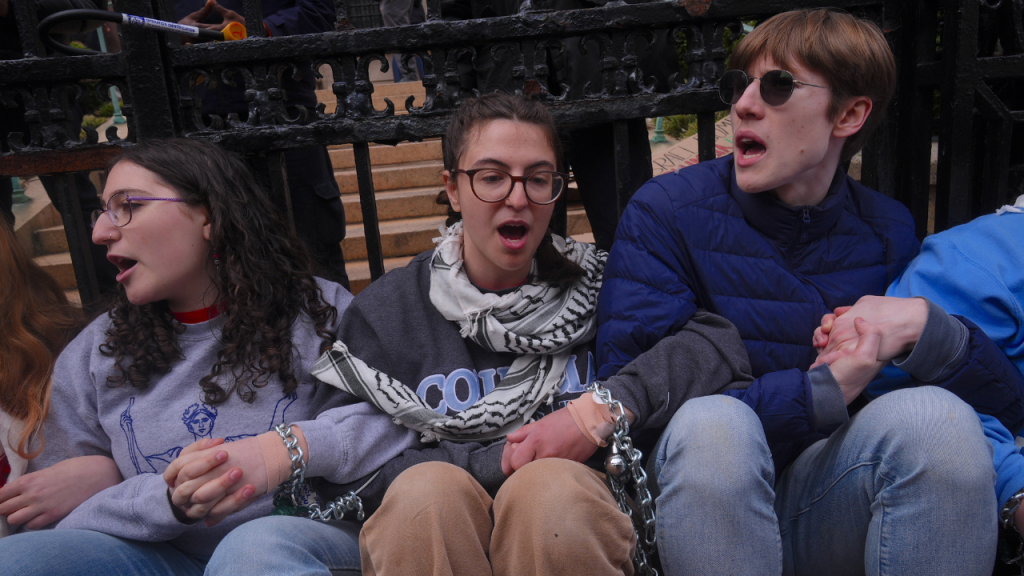Several students at Columbia University took a bold stand by chaining themselves to a gate on campus to protest the detention of fellow student Mahmoud Khalil by Immigration and Customs Enforcement (ICE). Their demonstration, which took place outside St. Paul’s Chapel, is aimed not only at raising awareness about Khalil’s case but also at calling for accountability from university trustees for their involvement in reporting him to ICE. The escalating situation highlights significant concerns regarding immigration law, university governance, and student activism, sparking widespread discussions on freedom of speech and the university’s responsibility in such matters.
| Article Subheadings |
|---|
| 1) Massive student protest ensues at Columbia University |
| 2) Actions taken by university officials during the protest |
| 3) Background on Mahmoud Khalil’s detainment |
| 4) Broader implications of the protests for immigrant rights |
| 5) University’s responsibility towards its students |
Massive student protest ensues at Columbia University
The protest at Columbia University began on a Wednesday afternoon when a group of students from the Columbia Palestine Solidarity Committee decided to hold a demonstration aimed at shedding light on the circumstances surrounding the arrest of Mahmoud Khalil. Approximately four students chained themselves to the gates of St. Paul’s Chapel, voicing demands for accountability and transparency regarding which university trustees were involved in his reporting to ICE. The protesters chanted slogans such as,
“Free Mahmoud Khalil. Name the trustee.”
In total, around 80 supporters rallied outside the gate, emphasizing their solidarity with Khalil and their disapproval of the university’s role in his detention.
Actions taken by university officials during the protest
Officials from Columbia University quickly responded to the protest. A spokesperson for the institution confirmed that public safety officers intervened after observing around two hours of disruption, resulting in the removal of the students chained to the gates. According to the spokesperson, the individuals complied with requests for identification but refused to vacate the area. Consequently, the chains were removed, and the protesters were escorted off the campus grounds. The university’s statement described the situation as a violation of the Rules of University Conduct, indicating a firm stance against such demonstrations on campus.
Background on Mahmoud Khalil’s detainment
Mahmoud Khalil, a prominent figure in Columbia’s anti-Israel protests, was detained by ICE agents in early March while in New York City. The Department of Homeland Security alleges that his activities were “aligned to Hamas,” which the agency designates as a terrorist organization. Khalil, having come from Syria in 2022 and having become a permanent resident by 2024, has been an outspoken advocate for Palestinian rights. The arguments surrounding his arrest have stoked discussions on freedom of speech, immigrant rights, and the university’s involvement in the political landscape.
Broader implications of the protests for immigrant rights
The protests at Columbia University reflect a growing concern among students regarding the treatment of immigrants, particularly those engaged in political activism. The situation calls into question the broader implications of how universities and their trustees interact with immigration authorities. Many see Khalil’s arrest as emblematic of a crackdown on immigrant students and activists who dare to challenge the status quo. The demonstration gathered traction not just within the university but also across various social media platforms, emphasizing a collective demand for support from institutions catering to a diverse student body.
University’s responsibility towards its students
Columbia University’s role in this situation raises significant questions about its responsibility towards its students, especially those facing legal challenges. As calls for transparency regarding the trustees responsible for reporting Khalil to ICE mount, many argue that the university should safeguard its students’ rights to express dissent without fear of repercussions. The incident has sparked a debate about how universities should intervene when allegations of misconduct arise among their trustees and how they can better protect students’ rights moving forward.
| No. | Key Points |
|---|---|
| 1 | Columbia University students protested against the arrest of Mahmoud Khalil by chaining themselves to campus gates. |
| 2 | University officials swiftly intervened, removing protesters on grounds of violating university conduct rules. |
| 3 | Khalil’s detention is linked to allegations of his alignment with Hamas, leading to concerns over freedom of expression on campus. |
| 4 | The protest reflects significant student concerns regarding immigrant rights and the treatment of activists. |
| 5 | There is an ongoing debate about university responsibilities in protecting students from legal predicaments related to their activism. |
Summary
The protests at Columbia University illustrate the complexities surrounding immigration issues and student activism. As students demand accountability from the university’s trustees in light of Mahmoud Khalil’s detention, broader themes of freedom of speech, institutional responsibility, and immigrant rights emerge. This event not only underscores the tensions inherent in university governance but also reflects an ongoing struggle among students and advocates to ensure that their voices are heard and protected in a legally precarious environment.
Frequently Asked Questions
Question: Who is Mahmoud Khalil?
Mahmoud Khalil is a Columbia University student and activist noted for his involvement in protests against Israel. He was detained by ICE amid allegations of having ties to Hamas.
Question: What were the main demands of the protesters?
The protesters demanded accountability from university trustees regarding who reported Khalil to ICE and insisted that those responsible be identified openly.
Question: How did the university respond to the protest?
Columbia University officials stated that they removed the protesters after they disrupted the area for around two hours and violated university conduct rules.



